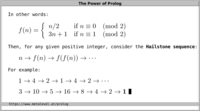

“Mathematics may not be ready for such problems. The Berkeley Open Infrastructure for Network Computing 2 ( BOINC, pronounced / bk / rhymes with 'oink' 3) is an open-source middleware system for volunteer computing (a type of distributed computing ).

We generate even-only and odd-only Collatz subsequences that contain significantly fewer elements term by term, to 2 and 1, respectively, than are present in the original 3n. The sequence of numbers involved is sometimes referred to as the hailstone sequence or hailstone numbers (because the values are usually subject to multiple descents and ascents like hailstones in a cloud), or as wondrous numbers. The collatz sequence of a number N is defined as: If N is Odd then change N to 3N + 1. We represent the generalized Collatz function with the recursive ruler function r (2n) r (n) + 1 and r (2n + 1) 1. No such sequence has been found.įor example starting with 12 we get the sequence 12, 6, 3, 10, 5, 16, 8, 4, 2, 1. Especially for BOINC.RU a few questions answered one of the project. Such a sequence would either enter a repeating cycle that excludes 1, or increase without bound. About project Collatz Conjecture first-hand (Interview with the Project Manager). If the conjecture is false, it can only be because there is some starting number which gives rise to a sequence that does not contain 1. If, for some n, such an i doesn’t exist, we say that n has infinite total stopping time and the conjecture is false. It can run on an nVidia GPU, ATI GPU, Intel. Collatz Conjecture Website Project info: Collatz Conjecture is based in Wood Dale, Illinois, USA and continues the work of the previous 3x+1home BOINC project which ended in 2008. The conjecture asserts that every n has a well-defined total stopping time. This thread is specifically for Collatz Conjecture project support. That smallest i such that a i = 1 is called the total stopping time of n. (that is: a i is the value of f applied to n recursively i times a i = f i( n)).


 0 kommentar(er)
0 kommentar(er)
